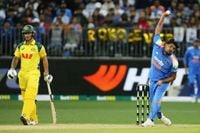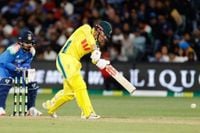The Sydney Cricket Ground buzzed with anticipation on October 25, 2025, as India and Australia prepared to square off in the third and final One-Day International of their high-stakes series. With the series already decided in Australia’s favor after victories in Perth and Adelaide, the contest in Sydney was about more than just numbers on a scoreboard—it was about pride, redemption, and the pursuit of a morale-boosting win for the visiting side.
Australia, led by skipper Mitchell Marsh, entered the match riding a wave of momentum. Marsh, who had guided his team to a seven-wicket win in a rain-affected opener in Perth and a tense two-wicket triumph in Adelaide, looked to cap off a dominant series on home soil. The Australians made just one change to their lineup for the Sydney showdown, bringing in Nathan Ellis for Xavier Bartlett, a move Marsh hoped would bolster their bowling attack on a pitch known for favoring batsmen early and spinners later.
India, meanwhile, found themselves in unfamiliar territory—0-2 down in a bilateral ODI series and desperate to avoid a whitewash. Captain Shubman Gill, taking the reins for this tour, was forced into changes after Nitish Kumar Reddy sustained a left quadriceps injury during the second ODI in Adelaide. The team management confirmed, "Nitish Kumar Reddy sustained a left quadriceps injury during the second ODI in Adelaide and was subsequently unavailable for selection for the third ODI. The BCCI medical team is monitoring him on a daily basis." In response, Gill brought in wrist-spinner Kuldeep Yadav and seamer Prasidh Krishna, dropping Arshdeep Singh and the injured Reddy. Kuldeep’s inclusion was particularly noteworthy—his omission from the first two ODIs had raised eyebrows, given the Sydney pitch’s reputation for assisting spinners as matches progress.
Speaking at the toss, which Australia won for the third time in the series, Gill reflected on the challenges his side faced. "We would have bowled first. Have a target on the total and then try to chase down, I think we got what we wanted. We had just enough runs (in the last game) on the board and a couple of chances coming our way which we couldn't take. That happens in the game of cricket, you've got to take your chances. The game was going on pretty even till about the 40th over. In the end, they played well. Hopefully this game is going to be a good one for us. Two changes. Kuldeep and Prasidh come in for Arshdeep and Reddy," Gill said, hinting at a renewed focus and determination.
Australia’s XI featured Marsh (captain), Travis Head, Matthew Short, Matt Renshaw, Alex Carey (wicketkeeper), Cooper Connolly, Mitchell Owen, Nathan Ellis, Mitchell Starc, Adam Zampa, and Josh Hazlewood. India countered with Rohit Sharma, Gill himself, Virat Kohli, Shreyas Iyer, Axar Patel, KL Rahul (wicketkeeper), Washington Sundar, Harshit Rana, Kuldeep Yadav, Mohammed Siraj, and Prasidh Krishna.
The Indian team’s record at the Sydney Cricket Ground, however, loomed like a dark cloud. Of the 19 ODIs played against Australia at this venue, India had managed just two wins, suffering 16 defeats, with one match abandoned. Their last victory here came in 2016, buoyed by stellar performances from Virat Kohli and Rohit Sharma. Since then, Sydney had been an unhappy hunting ground for the Men in Blue. The pitch’s dual nature—offering plenty to batsmen early on and gradually aiding spinners—meant that winning the toss and batting first was widely regarded as the optimal strategy. Of the 168 ODIs played at the SCG, teams batting first had triumphed 96 times, while those chasing had only 64 wins to their name.
Coming into the decider, India’s batting lineup was under scrutiny. In Adelaide, they posted 264-9, anchored by Rohit Sharma’s composed 73 from 97 balls. Shreyas Iyer contributed 61, while Axar Patel chipped in with a brisk 44. Yet, the middle and lower order faltered under pressure from Australia’s disciplined bowling, led by Adam Zampa (4-60) and Xavier Bartlett (3-39). The most glaring concern, though, was the form of Virat Kohli. For the first time in his illustrious ODI career, Kohli registered two consecutive ducks—both at the hands of Bartlett—leaving fans and pundits alike stunned. Kohli, who debuted in ODIs back in 2008, had never before experienced such a lean patch in the format.
Australia’s chase in the second ODI was a showcase for their next generation. Matt Short, batting with a painful finger injury, crafted a fluent 74 from 78 balls, while Cooper Connolly produced a career-best unbeaten 61 from just 53 deliveries in only his fourth ODI knock. Mitch Owen’s explosive 36 from 23 balls, featuring three sixes and two boundaries, further highlighted Australia’s depth. The trio came together at a precarious 187-5, but their composure and aggression saw the hosts home with 22 balls to spare. "It was good fun," Connolly said after the match. "My first couple of innings playing for Australia, I actually didn't bat, I was just sitting on the side watching the boys."
India’s captain for the second ODI, Shubman Gill, later admitted, "I think we had just enough runs on the board... it's never easy to defend those totals when you drop a couple of catches. There was a little bit in the wicket initially, but as the ball got older it got better to bat on." These dropped chances and missed opportunities had haunted India throughout the series, with Australia capitalizing at every turn.
As the teams took the field in Sydney, the stakes were clear. For Australia, it was a chance to complete a rare clean sweep against a major rival. For India, it was about salvaging pride and building momentum ahead of the upcoming five-match T20 series, which was set to begin on October 29, 2025. The tour’s narrative had shifted from series contention to damage control and experimentation, with the likes of Kuldeep Yadav and Prasidh Krishna eager to make their mark.
Looking beyond this ODI series, both squads faced busy schedules. Australia would soon turn their attention to the prestigious Ashes Test series against England, while India’s focus would shift to limited-overs cricket and refining their combinations for future challenges.
With the match underway and the action still unfolding in Sydney, all eyes remained glued to the SCG. Would India finally break their Sydney jinx and end the series on a high, or would Australia’s young guns continue their impressive run? One thing was certain: pride, history, and future selection stakes all hung in the balance as the final ODI played out under the iconic Sydney skyline.

